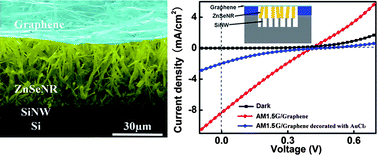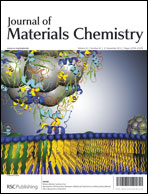The narrow indirect bandgap of Si hinders the full absorption and utilization of the solar light. Energy band engineering to the Si based photovoltaic devices is essential to address this problem. Here we report the fabrication of ZnSe nanoribbon (ZnSeNR)/Si nanowire (SiNW) p–n heterojunction arrays by directly growing or simply drop-casting the p-type ZnSeNRs on highly aligned n-type SiNW arrays. Phosphorus (P) was used as dopant to achieve robust p-type doping in the ZnSe nanostructures with a hole concentration as high as 6.5 × 1018 cm−3. Thanks to the matched bandgap and the light trapping arising from the one-dimensional (1D) array structure, the heterojunction arrays exhibited improved light absorption, particularly in the blue/UV wavelength range. Moreover, by taking advantage of the ohmic contact between graphene and p-ZnSeNR, heterojunction array solar cells with graphene transparent electrode were fabricated, giving rise to a power conversion efficiency of ∼0.78% under AM 1.5G illumination. It was found that the surface passivation to the SiNW array played an important role in determining the device performance; an efficiency up to 2.27% was obtained after surface modification with methyl groups. Our results demonstrate the heterojunction arrays, together with the graphene transparent electrodes, could be promising candidates for high-performance and low-cost photovoltaic applications.

You have access to this article
 Please wait while we load your content...
Something went wrong. Try again?
Please wait while we load your content...
Something went wrong. Try again?


 Please wait while we load your content...
Please wait while we load your content...